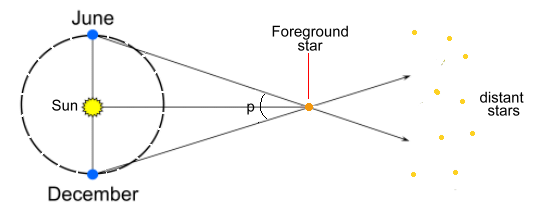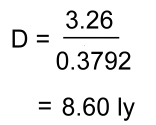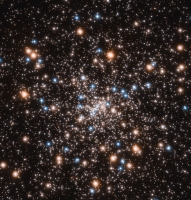 Parallax is what happens as an object appears to move when we change our point of view. In astronomy, it is an irreplaceable tool for calculating distances to far away stars. Here's an example of parallax. Extend your arm, close your right eye, and raise your thumb. Place your thumb over a distant object. Now, switch eyes, so that your left is closed and your right is open. Your thumb will appear to shift slightly against the background. That's parallax. By measuring this small change and knowing the distance between your eyes, you could calculate the distance to your thumb using trigonometry. More importantly, we can calculate the distances to stars this way! Observed from Earth, the night sky appears two-dimensional. But it's not. Each of the twinkling lights you see are at different distances from Earth, ranging from planets in our solar system which could be hundreds of millions of kilometres from us, to distant stars, the nearest of which, Alpha Centauri, is an incredible 41,000,000,000,000 (41 trillion) kilometres away ... so far away that we measure the distance in light years, the distance light travels in a year. Alpha Centauri is 4.3 light years away. However, it took astronomers thousands of years to figure out how to measure distances of stars from our planet, and create actual three-dimensional maps reflecting the distribution of stars and galaxies in the universe. One of the most important methods they use is parallax. The orbit of Earth around the sun provides the baseline for these calculations.  As Earth moves in its orbit around the Sun, from June to December, it's position changes by a distance of
300 million kilometres.
As Earth moves in its orbit around the Sun, from June to December, it's position changes by a distance of
300 million kilometres.The parallax angle 'p' to a nearby star can be measured as the star seems to move against the background of much more distant stars. Due to the vast distances to even the nearest stars, however, the perceived shift is barely noticeable, and measuring it is extremely difficult. The first known astronomical measurement using parallax didn't involve a star but the moon. The ancient Greek astronomer Hipparchus in 170 BC reportedly used observations of a solar eclipse from two different locations to calculate the lunar distance. In 1672, Italian astronomer Cassini and his colleague Jean Richer made simultaneous observations of Mars, with Cassini in Paris and Richer in French Guiana. Cassini then used those measurements to calculate the parallax, determining Mars' distance from Earth. The first person to succeed at measuring the distance to a star using parallax was the German astronomer Friedrich Bessel in 1838. Based on his observations, he calculated that the star 61 Cygni must be about 10 light years away from Earth. This was the beginning of the long process of actually building a three-dimensional map of the universe. Let's look at an actual calculation by using parallax to find the distance to the star Sirius. The distance D is determined using the formula:  where: D = distance in light years P is half the parallax angle p For Sirius, that angle P is very small: 0.3792 arc-seconds (an arc-second is 1/3600th of a degree) Here's the calculation: 
Astronomers, aided by improvements in telescope technology, gradually grew the catalogs of stellar distances using the parallax method. In 1924, American astronomer Frank Schlesinger published a catalogue with the parallaxes of almost 2,000 stars, determining stellar distances out to a few dozen light-years from Earth. His catalogue was extended to about 6,000 stars by Louise Jenkins in 1952, and to over 8,000 stars by William van Altena in 1995. A real breakthrough in parallax measurement and in determining distances of stars in our galaxy, the Milky Way, came with a mission called Hipparcos, after the ancient Greek astronomer. This mission, launched in 1989, measured the positions and parallaxes as well as proper motions (the motion of a star on the sky observed over the years that is not caused by the parallax but reflects the actual movement of the star in space), for nearly 120,000 stars. The spacecraft orbited Earth for about four years, allowing astronomers to probe the neighbourhood of the sun up to the distance of 300 light-years with an accuracy of 0.001 arcseconds. Two decades after the end of the Hipparcos mission, another breakthrough was made after the 2013 launch of an orbiting telescope called Gaia that charts the positions, parallaxes, and proper motions of more than one billion stars. That number represents only about 1% of the actual number of stars in our galaxy, but that's enough for astronomers to extrapolate the observations to understand how the Milky Way behaves as a whole. Gaia has nearly a billion pixels in its detectors, larger mirrors than Hipparcos, and can observe thousands of stars at the same time. Using Gaia data, they could, for the first time, create a dynamic movie of the galaxy's life over billions of years, uncovering past events but also projecting what will happen in the future.  At some point, stars and galaxies get too distant to have their parallax measured even by the most sensitive instruments. But astronomers have other tools they can use. For example, by measuring the distances to a number of nearby stars, astronomers have been able to establish relationships between a star's colour and its intrinsic brightness (the brightness it would appear to have if viewed from a standard distance). These stars then become baselines. By comparing the colour and spectrum of far distant stars to these, astronomers can determine the star's intrinsic brightness. By comparing the intrinsic brightness to the star's apparent brightness in the sky, we can infer the star's distance by using the inverse square rule. Moreover, if a star measured in this way happens to be part of a distant cluster, we can assume that all of those stars are at roughly the same distance, and we can add them to the libraries.
At some point, stars and galaxies get too distant to have their parallax measured even by the most sensitive instruments. But astronomers have other tools they can use. For example, by measuring the distances to a number of nearby stars, astronomers have been able to establish relationships between a star's colour and its intrinsic brightness (the brightness it would appear to have if viewed from a standard distance). These stars then become baselines. By comparing the colour and spectrum of far distant stars to these, astronomers can determine the star's intrinsic brightness. By comparing the intrinsic brightness to the star's apparent brightness in the sky, we can infer the star's distance by using the inverse square rule. Moreover, if a star measured in this way happens to be part of a distant cluster, we can assume that all of those stars are at roughly the same distance, and we can add them to the libraries.
|